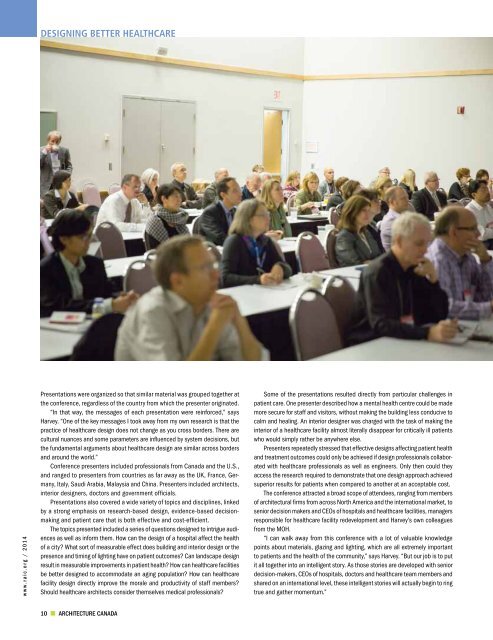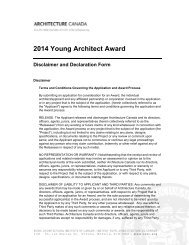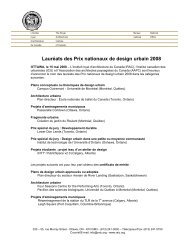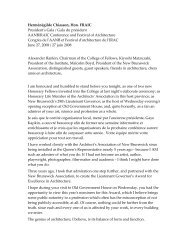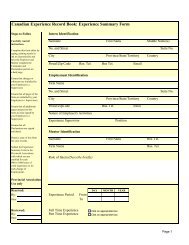Justice Architecture - Royal Architectural Institute of Canada
Justice Architecture - Royal Architectural Institute of Canada
Justice Architecture - Royal Architectural Institute of Canada
Create successful ePaper yourself
Turn your PDF publications into a flip-book with our unique Google optimized e-Paper software.
DEsigning better healthcare<br />
www.raic.org / 2014<br />
Presentations were organized so that similar material was grouped together at<br />
the conference, regardless <strong>of</strong> the country from which the presenter originated.<br />
“In that way, the messages <strong>of</strong> each presentation were reinforced,” says<br />
Harvey. “One <strong>of</strong> the key messages I took away from my own research is that the<br />
practice <strong>of</strong> healthcare design does not change as you cross borders. There are<br />
cultural nuances and some parameters are influenced by system decisions, but<br />
the fundamental arguments about healthcare design are similar across borders<br />
and around the world.”<br />
Conference presenters included pr<strong>of</strong>essionals from <strong>Canada</strong> and the U.S.,<br />
and ranged to presenters from countries as far away as the UK, France, Germany,<br />
Italy, Saudi Arabia, Malaysia and China. Presenters included architects,<br />
interior designers, doctors and government <strong>of</strong>ficials.<br />
Presentations also covered a wide variety <strong>of</strong> topics and disciplines, linked<br />
by a strong emphasis on research-based design, evidence-based decisionmaking<br />
and patient care that is both effective and cost-efficient.<br />
The topics presented included a series <strong>of</strong> questions designed to intrigue audiences<br />
as well as inform them. How can the design <strong>of</strong> a hospital affect the health<br />
<strong>of</strong> a city? What sort <strong>of</strong> measurable effect does building and interior design or the<br />
presence and timing <strong>of</strong> lighting have on patient outcomes? Can landscape design<br />
result in measurable improvements in patient health? How can healthcare facilities<br />
be better designed to accommodate an aging population? How can healthcare<br />
facility design directly improve the morale and productivity <strong>of</strong> staff members?<br />
Should healthcare architects consider themselves medical pr<strong>of</strong>essionals?<br />
Some <strong>of</strong> the presentations resulted directly from particular challenges in<br />
patient care. One presenter described how a mental health centre could be made<br />
more secure for staff and visitors, without making the building less conducive to<br />
calm and healing. An interior designer was charged with the task <strong>of</strong> making the<br />
interior <strong>of</strong> a healthcare facility almost literally disappear for critically ill patients<br />
who would simply rather be anywhere else.<br />
Presenters repeatedly stressed that effective designs affecting patient health<br />
and treatment outcomes could only be achieved if design pr<strong>of</strong>essionals collaborated<br />
with healthcare pr<strong>of</strong>essionals as well as engineers. Only then could they<br />
access the research required to demonstrate that one design approach achieved<br />
superior results for patients when compared to another at an acceptable cost.<br />
The conference attracted a broad scope <strong>of</strong> attendees, ranging from members<br />
<strong>of</strong> architectural firms from across North America and the international market, to<br />
senior decision makers and CEOs <strong>of</strong> hospitals and healthcare facilities, managers<br />
responsible for healthcare facility redevelopment and Harvey’s own colleagues<br />
from the MOH.<br />
“I can walk away from this conference with a lot <strong>of</strong> valuable knowledge<br />
points about materials, glazing and lighting, which are all extremely important<br />
to patients and the health <strong>of</strong> the community,” says Harvey. “But our job is to put<br />
it all together into an intelligent story. As those stories are developed with senior<br />
decision-makers, CEOs <strong>of</strong> hospitals, doctors and healthcare team members and<br />
shared on an international level, these intelligent stories will actually begin to ring<br />
true and gather momentum.”<br />
10 ■ <strong>Architecture</strong> <strong>Canada</strong>


